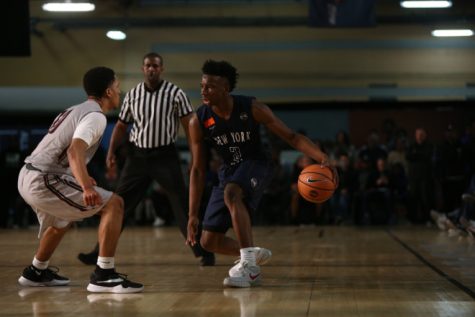The Age of AAU Basketball
January 23, 2017
It’s been a long while since high school basketball was the primary development for high school players across the country. Years ago, a player’s performance during their school season is what gave them national attention, offers, and a future. But the times have changed since then, and while high school basketball still can draw attention, it is nowhere the center of attention. There is a new focus for high school players. This new focus is the center of national attention for the development of high school players, and has drawn out coaches, colleges, and all the cameras. The entire country has shifted towards the new focus, which is AAU basketball. AAU basketball has corrupted basketball and given kids false hope.
AAU basketball has been around since 1888 but sprouted in the early 2000’s, and has increasingly grown to the incredible magnitude that it holds now. High school players are drawn to camps, tournaments, and showcases in order to demonstrate their talent in front of college coaches all across the country. Due to the attention given to AAU, kids have taken on the perception that school basketball means much less than AAU. They see the Ballislife mixtapes and desire to be heavily sought after and get a mixtape as well. They see the majority of the tapes produced in the summer during AAU, so they gravitate towards playing AAU and highly prioritizing AAU. The thing about mixtapes is that they don’t really show fundamentals, but instead they show dunking, shooting 3 pointers, and crossovers. Therefore, they prioritize AAU over school ball, emphasize flashy moves instead of fundamentals, and work hard to get mixtapes and attention. Those same players will receive offers and attention, yet half will fail at the collegiate level because of their lack of fundamentals or basketball IQ. Former NBA player and current Golden State Warriors head coach Steve Kerr spoke on AAU, saying “ If mom and dad aren’t happy with their son’s playing time, they switch club teams and stick him on a different one the following week. The process of growing as a team basketball player — learning how to become part of a whole, how to fit into something bigger than oneself — becomes completely lost within the AAU fabric.”

Kids grow up playing AAU. The more elite kids receive big titles early coupled with high expectations. They receive rankings and titles and have to told up to those expectations. All of these notions are received during AAU, the short period summer ball where coaches get a glimpse of the country’s best talent. With such a short period it’s difficult to properly rank and evaluate all players. However, these kids are evaluated nonetheless, and giving difficult comparisons to hold up to. Kids are playing AAU and being labeled as the next Kevin Durant or the next Kyrie Irving at 12 years old or so. As a result, if those kids don’t always perform like the 16 year old Kevin Durant or whoever they’re compared to, they’re soon labeled as overrated. Kids are practically set up for failure due to the broad comparisons they receive based off evaluation of the short stint of AAU basketball played in the summer. Former NBA player Maurice Taylor spoke on Steve Kerr’s thoughts on AAU, saying “Everything he said is true… These teams don’t value PRACTICE and TEAM play. Boys have to know how to play in a system and they can’t be given false hope of being the best thing since sliced bread!”
AAU is a sort of basketball that can be very political in the sense that the people you know matters. There are different leagues such as the Nike EYBL, the Under Armour Circuit, and the Adidas Nations Circuit. All have just about the same amount of exposure. But those are the elite teams of the country. Shoe companies like Nike use top gear and well known representatives to lure kids to their organizations. Some are sought after as early as middle school. Some kids are sought after so early due to talent, others due to connection. A freshman or sophomore playing on a 17U team that shouldn’t be and only is because the coach is his father or uncle, for example. Some kids decide to form super teams and come from another state to play for a certain EYBL, team up with other top recruits, and receive tons of exposure. That’s what kids in AAU do is seek exposure. The roots of AAU aren’t winning and fundamental basketball. The roots of AAU are flashiness and exposure. Winning isn’t important in AAU, and exposure replaces it completely. Whitney Young senior Derrick Faulkner played AAU basketball from 7th grade to this past year. He said “Kids play on AAU teams and get a big head and think they’re the man, but get back into the school season and don’t do what’s best for their high school team. Also, the commitment to the AAU team takes away time from working on a player’s individual skills.” Whitney Young senior Zach Everett coaches and has played AAU. He said “AAU is bad for a multitude of reasons. For one, kids can switch teams whenever they like and play on more than one team. Also, in AAU you play more games than you do practice, which is problematic and essentially the opposite of high school basketball. Lastly due to recruiting, AAU coaches have more power than high school coaches which devalues school.”
Overall, AAU basketball has replaced school basketball as the number one priority for high school players across the country. It is a glorified sort of basketball that has given kids false hope and untraditional morals. AAU has made exposure the number one priority for kids and undermined winning. AAU has undermined fundamentals, and overall given kids false hope through broad comparisons thrown out to players based off the short stint of AAU summer basketball.